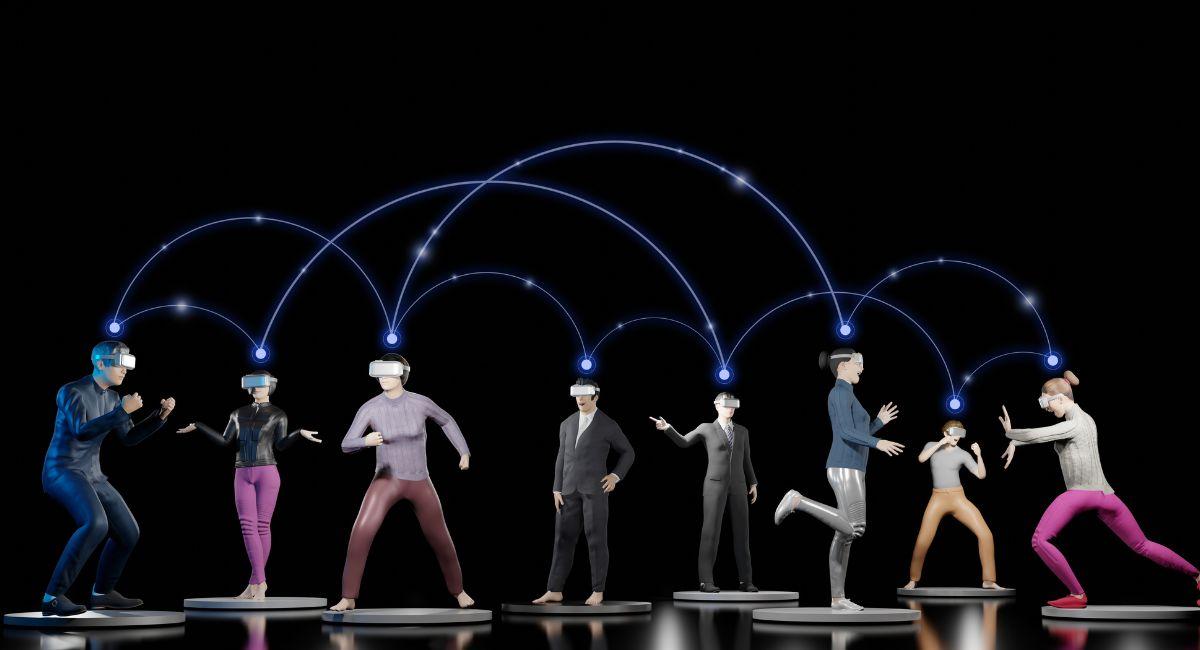Paving The Metaverse Future With Accessibility And User-Friendliness Through Open Standards And Cross-Platform Compatibility

In the fast-paced evolution of technology, the concept of the Metaverse has emerged as a transformative force, promising a digital realm where virtual and augmented realities converge to create immersive, interconnected experiences. As we stand on the cusp of this future, the imperative to make it accessible and user-friendly becomes paramount. This comprehensive exploration delves into the pivotal role of open standards and cross-platform compatibility in shaping a Metaverse that is not only inclusive but also seamlessly navigable for users across diverse devices and platforms.
The Metaverse Unveiled: A New Dimension of Digital Interaction:
Defining the Metaverse Landscape:
It represents a collective virtual space, an interconnected universe of digital experiences that transcend traditional boundaries. From social interactions to economic activities and virtual environments, the Metaverse is poised to redefine how we engage with the digital realm. However, for the Metaverse to realize its full potential, it must be accessible to a broad spectrum of users and foster seamless interactions across various devices and platforms.
Accessibility as a Cornerstone of Metaverse Evolution:
Breaking Down Digital Barriers:
Making the Metaverse accessible is not just about technological innovation; it’s a commitment to breaking down digital barriers. Accessibility encompasses considerations for individuals with diverse abilities, demographics, and technological infrastructures. Open standards and cross-platform compatibility play a pivotal role in ensuring that the Metaverse becomes a space where inclusivity is woven into its very fabric.
Cross-Platform Compatibility: Fostering Seamless Transitions and Interactions in the Metaverse

In the dynamic landscape, the concept of cross-platform compatibility emerges as a crucial enabler, bridging the gap between diverse devices and ensuring that users can traverse this digital realm seamlessly. This detailed exploration delves into the significance of cross-platform compatibility, unraveling how it facilitates seamless transitions and interactions for users, ultimately democratizing access to the Metaverse.
**1. The Foundation of Interconnected Experiences:
Creating a Unified Digital Landscape:
Cross-platform compatibility serves as the foundation for building an interconnected digital landscape within the Metaverse. Rather than existing as isolated islands of experience, different devices harmoniously contribute to a unified and seamless Metaverse. This unity is essential for fostering a sense of continuity and interconnectedness, allowing users to seamlessly transition between various virtual environments.
**2. Eliminating Device Exclusivity:
Empowering Users with Choice:
The traditional narrative of emerging technologies often includes an element of exclusivity, where access is restricted to specific devices. Cross-platform compatibility disrupts this narrative by empowering users with the choice to engage with the Metaverse using their preferred devices. Whether it’s VR headsets, AR glasses, smartphones, or traditional computers, users can seamlessly enter the Metaverse without constraints.
**3. Versatility Across Devices:
Adapting to User Preferences:
Users’ preferences for interaction vary, and cross-platform compatibility ensures that the Metaverse adapts to these diverse needs. Whether a user favors the immersive experience of VR, the convenience of AR on glasses, or the accessibility of a smartphone, a cross-platform approach allows the Metaverse to cater to a spectrum of user preferences, enhancing the versatility of digital experiences.
**4. Interoperability Beyond Technological Silos:
Breaking Down Technological Barriers:
Technological silos often hinder the interoperability of devices, creating a fragmented digital landscape. Cross-platform compatibility actively works to break down these barriers, fostering interoperability beyond the confines of specific technologies. This approach is instrumental in creating a Metaverse where users are not limited by the devices they own but are instead granted a cohesive and interconnected experience.
**5. Seamless Transitions Between Realities:
Fluid Movement Across Virtual Environments:
The Metaverse is characterized by the coexistence of virtual and physical realities. Cross-platform compatibility ensures that users can experience seamless transitions between these diverse realms. Whether moving from a VR-enhanced meeting to an AR-embedded urban exploration on a smartphone, the fluidity of transitions enhances the immersive nature of the Metaverse.
**6. Unified User Profiles:
Consistent Identities Across Devices:
Cross-platform compatibility extends beyond seamless transitions, encompassing the creation of unified user profiles. Users can maintain consistent identities and preferences across different devices, ensuring a cohesive experience. Whether engaging in social interactions, commerce, or content creation, a unified user profile contributes to a sense of continuity and personalization within the Metaverse.
**7. Collaborative Experiences Across Platforms:
Connecting Users in Shared Spaces:
The Metaverse is not just about individual experiences but also collaborative interactions. Cross-platform compatibility facilitates collaborative experiences by connecting users across different devices in shared virtual spaces. Whether attending a virtual event, collaborating on a project, or participating in a social gathering, users can seamlessly engage with others, irrespective of their chosen devices.
**8. Optimizing Experiences for Device Capabilities:
Enhancing Performance Across Variations:
Devices within the Metaverse vary significantly in terms of capabilities and specifications. Cross-platform compatibility allows the optimization of experiences based on the capabilities of each device. Whether leveraging the processing power of VR headsets or tailoring content for smartphone displays, this adaptability ensures that users receive an optimized experience regardless of the device they use.
**9. Cross-Reality Interactions:
Bridging Virtual and Physical Worlds:
The Metaverse blurs the boundaries between virtual and physical realities. Cross-platform compatibility facilitates cross-reality interactions, allowing users to engage with virtual elements overlaid onto the physical world through AR glasses or seamlessly transition between augmented and virtual experiences. This capability enhances the richness and complexity of user interactions within the Metaverse.
**10. Challenges and Considerations:
Navigating Technical and Design Complexities:
While cross-platform compatibility opens doors to a more inclusive Metaverse, it also presents technical and design challenges. Ensuring a consistent and high-quality experience across devices, addressing varying input mechanisms, and navigating the diversity of device specifications require careful consideration. Developers and innovators must balance the quest for inclusivity with the need for optimized performance.
Cross-platform compatibility stands as a pivotal pillar in shaping an inclusive Metaverse experience. By fostering seamless transitions and interactions across diverse devices, this approach democratizes access to the digital realm, empowering users with the freedom to choose how they engage with the Metaverse. As technology continues to advance, the collaborative spirit embodied in cross-platform compatibility ensures that the Metaverse becomes a space where everyone, regardless of their device, can contribute to and benefit from the rich tapestry of interconnected digital experiences.
Accessibility as a Cornerstone of Metaverse Evolution: Breaking Down Digital Barriers

In the ambitious journey towards shaping the emphasis on accessibility emerges as a cornerstone, reflecting a commitment to inclusivity that goes beyond technological innovation. Breaking down digital barriers is not merely a technical challenge; it is a concerted effort to consider and cater to the diverse needs of individuals in terms of abilities, demographics, and technological infrastructures. This comprehensive exploration delves into the significance of accessibility within the Metaverse, elucidating how open standards and cross-platform compatibility play a pivotal role in weaving inclusivity into its very fabric.
**1. Defining Accessibility in the Metaverse Context:
Beyond Technological Accessibility:
Accessibility in the Metaverse transcends mere technological considerations. It encompasses a holistic approach that addresses a broad spectrum of user needs, ensuring that the digital landscape is welcoming and usable for individuals with diverse abilities, backgrounds, and preferences. From the differently-abled to individuals with varying levels of technological literacy, the Metaverse aims to be an inclusive space.
**2. Considerations for Diverse Abilities:
Empowering Users of All Abilities:
The Metaverse, in its quest for accessibility, places a strong emphasis on empowering users of all abilities. This includes considerations for individuals with visual, auditory, motor, and cognitive impairments. Implementing features such as voice commands, haptic feedback, and customizable interfaces ensures that the digital experiences within the Metaverse are tailored to accommodate diverse abilities, fostering a sense of empowerment.
**3. Demographic Inclusivity:
Reflecting Global Diversity:
Accessibility within extends to demographic inclusivity, reflecting the global diversity of its user base. This involves considerations for users of different ages, cultural backgrounds, and language preferences. Designing interfaces, content, and interactions that resonate with a diverse audience is integral to breaking down cultural and demographic barriers, ensuring that the Metaverse is a space where everyone feels represented and included.
**4. Technological Infrastructure Considerations:
Navigating Varying Technology Landscapes:
Accessibility also involves navigating the varying technological infrastructures across different regions and communities. In some areas, high-speed internet and advanced devices may be prevalent, while in others, users may rely on more basic connectivity and older devices. Open standards and cross-platform compatibility become essential in optimizing the xperience across this diverse technological landscape, preventing exclusion based on infrastructure limitations.
**5. Open Standards as the Catalyst for Inclusivity:
Establishing Universally Accepted Protocols:
Open standards act as a catalyst for inclusivity. By establishing universally accepted protocols and specifications, open standards create a foundation for interoperability across diverse devices and platforms. This approach ensures that users are not confined to specific technologies, breaking down barriers and fostering a more inclusive digital environment.
**6. Cross-Platform Compatibility: Bridging Technological Gaps:
Seamless User Experiences Across Devices:
Cross-platform compatibility plays a vital role in bridging technological gaps and ensuring seamless user experiences. In a diverse technological landscape, where users engage with the Metaverse through VR headsets, AR glasses, smartphones, or traditional computers, cross-platform compatibility allows for a unified experience. This approach prevents device exclusivity and ensures that users can participate in the Metaverse using the devices they have access to.
**7. User-Friendly Interfaces: Intuitive and Inclusive Design:
Human-Centered Design Principles:
Accessibility is deeply intertwined with user-friendly interfaces that prioritize intuitive and inclusive design. Human-centered design principles guide the creation of interfaces that are easy to navigate, regardless of a user’s level of technological proficiency or ability. The Metaverse aims to provide interfaces that are not only visually appealing but also functional and adaptable to different user needs.
**8. Adaptive Technologies: Customizing the Experience:
Personalization for Diverse Preferences:
Adaptive technologies contribute to accessibility by allowing users to customize their experiences based on individual preferences. Whether it’s adjusting the font size for better readability, choosing language preferences, or configuring interaction modes, adaptive technologies empower users to tailor the Metaverse to suit their unique needs, fostering a sense of inclusivity.
**9. Inclusive Content Creation: Empowering Diverse Creators:
Enabling a Diverse Range of Voices:
The commitment to accessibility extends to content creation. Inclusivity involves empowering a diverse range of creators to contribute to the digital landscape. Tools and platforms that support creators with different perspectives, styles, and cultural influences contribute to a more varied and inclusive Metaverse, where the content resonates with a global audience.
**10. Education and Advocacy: Fostering Metaverse Literacy:
Empowering Users with Knowledge:
Accessibility within the Metaverse is not only about the technology itself but also about empowering users with knowledge. Educational initiatives and advocacy play a crucial role in fostering Metaverse literacy. By providing users with the understanding of available features, customization options, and inclusive design principles, education becomes a powerful tool in breaking down digital barriers and promoting inclusive participation.
Accessibility stands as a cornerstone in the evolution of the Metaverse, reflecting a commitment to breaking down digital barriers and fostering inclusivity. Open standards and cross-platform compatibility play instrumental roles in creating a space where users of diverse abilities, demographics, and technological infrastructures can engage seamlessly. As the Metaverse continues to evolve, the pursuit of accessibility ensures that it becomes a truly inclusive and empowering digital frontier, where everyone has the opportunity to participate, contribute, and shape the collective experience.
#LightCycle‘s metamorphic impact on the metaverse business landscape is undeniable! 🌐✨ Dive into @LightCycle_City innovative strategies driving an evolution in this virtual realm, shaping new standards and possibilities! 🚀💼 #Metaverse #VirtualRealm https://t.co/y4RmoWyMNV pic.twitter.com/DtI5BMNEC0
— TheCoinrise (@TheCoinriseCom) January 3, 2024
User-Friendly Interfaces: Bridging the Gap Between Virtual and Physical Realities

In the complex tapestry of the Metaverse, user-friendly interfaces emerge as the linchpin, facilitating a seamless and intuitive bridge between virtual and physical realities. At the heart of creating a welcoming space for all users, these interfaces play a pivotal role in ensuring that navigating virtual environments, interacting with augmented elements, and participating in virtual events are as instinctive as interacting with the physical world. This detailed exploration delves into the nuanced aspects of user-friendly interfaces, elucidating their significance in enhancing immersive experiences within the Metaverse.
**1. The Essence of User-Friendliness in the Metaverse:
Beyond Technological Complexity:
User-friendliness within the Metaverse extends beyond addressing technological complexities. It embodies a commitment to creating digital spaces that are accessible and enjoyable for users of varying technological proficiencies, backgrounds, and ages. Intuitive design principles become the cornerstone of this user-centric approach, fostering an environment where users can engage effortlessly with the Metaverse.
**2. Intuitive Design as the Guiding Light:
Human-Centered Design Principles:
Intuitive design in the Metaverse is guided by human-centered design principles. This approach places the user at the center of the design process, emphasizing empathy and understanding of user needs. Interfaces are crafted to be intuitive, ensuring that users can seamlessly navigate virtual landscapes, interact with augmented elements, and partake in virtual events without encountering steep learning curves.
**3. Bridging the Transition Between Realities:
Seamless Integration of Virtual and Physical:
The Metaverse is characterized by its unique ability to merge virtual and physical realities. User-friendly interfaces act as facilitators in bridging this transition. They seamlessly integrate virtual elements into the user’s field of view, ensuring that augmented reality overlays blend cohesively with the physical environment. This integration contributes to a sense of continuity, where users can effortlessly shift between the Metaverse and the tangible world.
**4. Navigation Simplicity in Virtual Environments:
Instinctive Movement Through Virtual Spaces:
Navigating virtual environments should mirror the instinctive movements within the physical world. User-friendly interfaces prioritize simplicity in navigation, allowing users to explore digital landscapes with ease. Whether traversing virtual cities, engaging in immersive gaming experiences, or attending virtual meetings, intuitive navigation enhances user agency and contributes to a more enjoyable Metaverse experience.
**5. Interactivity That Mimics Physical Actions:
Natural Gestures and Interactions:
Interactivity within the Metaverse should mirror natural physical actions. User-friendly interfaces leverage technologies such as gesture recognition, haptic feedback, and responsive touch controls to emulate real-world interactions. This approach ensures that users can interact with virtual objects and environments in a manner that feels familiar and intuitive, bridging the gap between the digital and physical realms.
**6. Adaptable Interfaces for Varied Devices:
Consistent Experience Across Platforms:
The Metaverse accommodates a diverse array of devices, from VR headsets and AR glasses to smartphones and traditional computers. User-friendly interfaces are adaptable, ensuring a consistent experience across these varied platforms. Whether engaging in virtual reality simulations or augmented reality applications, users encounter interfaces that are optimized for the specific capabilities and limitations of their chosen devices.
**7. Feedback Mechanisms for User Guidance:
Enhancing User Understanding:
User-friendly interfaces incorporate feedback mechanisms that enhance user understanding. Visual cues, auditory feedback, and haptic responses provide guidance within virtual environments, ensuring users are aware of their surroundings, actions, and potential interactions. These feedback mechanisms contribute to a more immersive experience by fostering a sense of presence and responsiveness within the Metaverse.
**8. Personalization for Individual Preferences:
Tailoring the Metaverse Experience:
User-friendly interfaces acknowledge the diversity of user preferences. Personalization options, such as customizable layouts, color schemes, and interaction modes, empower users to tailor the experience to align with their individual preferences. This adaptability enhances user comfort and engagement, fostering a sense of ownership within the digital landscape.
**9. Integrating Augmented Elements Seamlessly:
Augmented Reality in Harmony with Reality:
In augmented reality experiences, user-friendly interfaces ensure the seamless integration of augmented elements into the user’s physical surroundings. Augmented information, whether overlaid on real-world objects or integrated into the user’s field of view, is presented in a way that complements and enhances the physical environment. This harmony between augmented and physical elements contributes to a cohesive and immersive experience.
**10. Usability Across Age Groups:
Creating an Inclusive Digital Space:
User-friendly interfaces in the Metaverse transcend age barriers, creating an inclusive digital space for users of all generations. Designs take into account varying levels of technological familiarity, ensuring that both younger and older users can engage effortlessly with virtual and augmented realities. This inclusivity contributes to the Metaverse becoming a space where individuals from diverse age groups can connect and share experiences.
User-friendly interfaces stand as the catalyst for fostering seamless immersion. Guided by intuitive design principles, these interfaces bridge the gap between virtual and physical realities, ensuring that users can navigate, interact, and participate in digital experiences with ease. As the Metaverse continues to evolve, the commitment to user-friendly interfaces becomes a testament to creating a digital frontier that is not only technologically advanced but also welcoming, inclusive, and harmoniously integrated into the fabric of users’ lives.
Also, read- Exploring The Essence Of The Metaverse From The Perspective Of “Value”
Conclusion: Navigating the Metaverse’s Inclusive Horizon:
In conclusion, the future hinges on its ability to embrace accessibility and user-friendliness. Open standards and cross-platform compatibility serve as guiding principles in navigating the path toward a Metaverse that is inclusive, seamlessly connected, and welcoming to users from all walks of life. As we embark on this transformative journey, it’s not just about envisioning a digital frontier—it’s about co-creating a Metaverse where the doors are open to everyone, and the possibilities are boundless. By prioritizing accessibility and user-friendliness, we pave the way for a Metaverse that truly belongs to us all.


























































